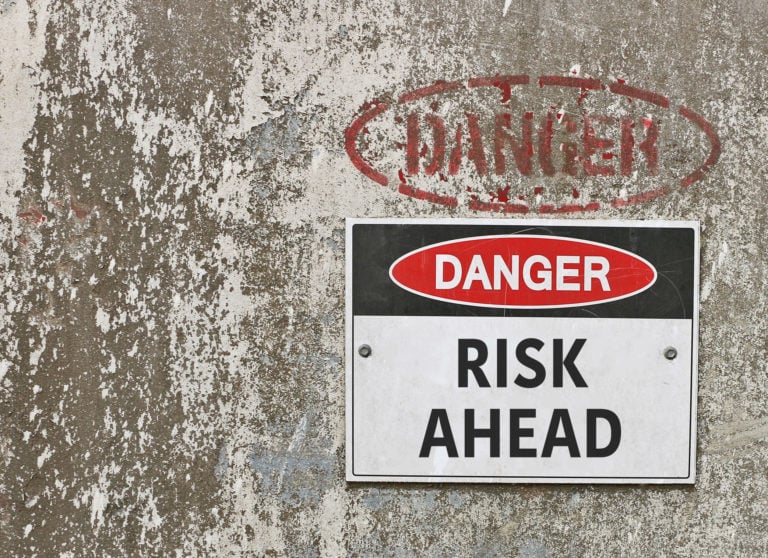Just because the calendar has changed doesn’t mean the investing environment has changed. The same problems we had when leaving 2022 are still here in 2023, presenting investment risks to investors.
Let’s not sugarcoat it: 2022 was a hard and painful year.
Equities suffered as the S&P 500 fell about 20%, while the Nasdaq dropped even more, falling 33%. Because of the financial power of mega-cap tech, the Nasdaq has usually kept pace with the S&P 500 on the downside while demonstrating more upside potential. That wasn’t the case in 2022.
Further, cryptocurrencies were hammered, and bonds had one of their worst years on record. In fact, many facets of the bond market had their worst year of performance since 1900.
While we will eventually dig ourselves out of this mess, what investment risks are still present?
Investment Risks: Recession

A recession is one of the top investment risks as we enter 2023. Say what you will about the economy, but should the U.S. slip into a recession, it will hurt more than just the tech industry.
Tech is going through a recession of its own, but once ad spending, consumer spending, and investments come down, the industry will face another wave of difficulties. The consumer has been resilient, but they can only hold up for so long.
Make it a global recession rather than just a domestic recession — given the strength of the U.S. consumer vs. other consumer-based economies — and the situation gets even worse for multinational companies.
Lower sales tend to equal lower earnings, and lower earnings equal lower stock prices.
The good news? The stock market tends to bottom before the economy bottoms, so we may not be all that far away from some good news in stocks, even if there is a recession.
Investment Risks: Inflation

If inflation can’t get brought under control, it will continue to wreak havoc on the economy. Although prices are coming down, there’s still a risk that we end up in an ultra-high-inflation environment.
Thankfully, that doesn’t seem to be the trajectory we’re on right now.
However, if inflation remains stubbornly high, it will erode the purchasing power of consumers and keep costs elevated for companies. Think of how high fuel costs or logistic costs impact consumers, then think of the companies shipping millions of products all over the world.
Again, inflation is coming down, but it needs to stay down in order for the next risk on our list to stay at bay.
Investment Risks: Interest Rates (and the Federal Reserve)

I want investors to understand one thing: Don’t fight the Fed.
Yes, it’s possible for stocks to rally when interest rates are elevated. Further, there are other considerations outside of the Fed when determining whether traders and investors should be long, flat, or short stocks.
However, when the Fed is hawkish, risk assets like stocks tend to perform poorly. The riskier the stock, the worse it performs. Just look at Roku (NASDAQ:ROKU
) vs. International Business Machines (NYSE:IBM) or Apple (NASDAQ:AAPL) vs. PepsiCo (NASDAQ:PEP).
When we look back over the last 10 to 12 years, the Fed has been accommodative for most of those years. That is to say; it’s been dovish most of the time.
It tried to change its tune in the third quarter of 2018. By the time December rolled around a few months later, the S&P 500 and Nasdaq had fallen 20% and 23%, respectively. It was an annihilation. Considering that the S&P 500 suffered a peak-to-trough decline of 27.5% in 2022, and it took about ten months to do it, a three-month 20% decline was brutal.
After again moving from dovish to hawkish last year, stocks have paid the price. So the risk is pretty simple: If the Fed remains aggressively hawkish, stocks are in trouble.
For now, though, the Fed is expected to raise rates just a bit from current levels, then maintain those rates for most of 2023. Let’s see if that’s the case.
Dollar Strength

Another one of our investment risks to watch is the US dollar. This can be followed via the US Dollar Index (DXY) or the Invesco DB US Dollar Index Bullish Fund (NYSEARCA:UUP), both of which performed quite well in 2022.
While a strong dollar may be great for travelers when they go overseas, it’s not great for multinational companies with a global footprint.
Those companies’ overseas profits are now worth less, putting a squeeze on earnings. And as we discussed before, lower earnings tend to equal lower stock prices, as valuations generally decline.
Volatility

Lastly, keep in mind volatility is still a major risk for investors this year. The S&P 500 just trudged through a terrible year. Bonds have as well, as yields, currencies, and many other asset classes bounce around.
Volatility in and of itself isn’t necessarily bad, but it can push investors into making poor, emotionally-driven decisions.
One way to counter that is by keeping a higher-than-usual cash position on hand and by taking smaller position sizes. If you usually allocate 8% to 10% of your portfolio to one position, consider a 4% to 5% stake.
If you are someone who goes all-in and all-out of index positions — like the SPDR S&P 500 ETF Trust (NYSEARCA:SPY) — then consider half-sized positions.
Just know that elevated volatility can create sudden and unexpected moves, and investors need to find ways to counter those potential hazards.
On the date of publication, Bret Kenwell did not have (either directly or indirectly) any positions in the securities mentioned in this article. The opinions expressed in this article are those of the writer, subject to the InvestorPlace.com Publishing Guidelines.
